Aventuras De Viaje's Blog, page 11
June 22, 2017
9 Cool Things to Do in Gyeongju, South Korea
This list of 9 cool things to do in Gyeongju gives a short review of each of the things to do in Gyeongju, links to more detailed reviews (where applicable), and advise on accommodation in Gyeongju as well as information on getting to Gyeongju.
After spending the weekend in Seoul I went to Gyeongju for the week (mon-fri) before meeting up with Ayase back in Seoul. It was good to get out of the big city and I had plenty to keep me busy in Gyeongju. It was a good place.
9 Cool Things to do in Gyeongju
1. Anapji Pond
I arrived in Gyeongju around 5:30pm and after a little rest I went to grab some dinner. The lady at my accommodation suggested I check out Anapji Pond, so I did. There are a few things to look at in that area so it turned out to be much more than just a pond. I didn’t end up eating until about 9pm.

2. Bulguksa Temple
On my first full day in Gyeongju I headed out to see Bulguksa Temple and the Seokguram Grotto. I never made it to the grotto but managed to get halfway up Tohamsan Peak instead.
It was a nice walk around the temple and an even nicer hike up through the woods.

A pond in Bulguska Temple.
3. Seongdong and Jungang Markets
Across the road from the train station bus stop there is the Seongdong market. A great place to get some fresh fruit and vegetables. Also has other stuff inside like fish, meat, and non-food products. Perhaps get yourself a souvenir. Also some small eateries.
Almost directly across the road from the train station bus stop is a shop selling freshly made Korean Bao. Im not sure the real name, but they are extremely similar to Chinese bao zi, only way more delicious – and that’s saying something because Chinese bao zi are already pretty delicious! 1,000 KRW each.
Jungang Market (which is more in the center of town) is much the same but seems to have a bit more in the ready-to-eat food department. I think the “snack stalls” open around 7pm. Before then it is fresh fruit and vegetables.

Inside Seongdong Market.
4. Yangdong Folk Village
Yangdong Folk Village is a traditional village which you can walk around and look at the architecture of that period. People still live there and there are lots of private residence. You can also go for a little hike up the mountain.

Looking over Yangdong from the top of the peak.
5. Tumuli Park
A mid-sized park full of burial mounds (which I originally thought were natural). I didn’t actually go in but took this picture from the gate. Seems like a nice place for a walk-about, but I had done a lot of walking when I went past it so opted to get food instead.

Looking into Tumuli Park from the street.
6. River Walk
In the late afternoon / early evening, cross the busy road and go down next to the river. There is a big walking/cycle path. I’m not sure how long it goes for.

The river coming into dusk.
7. Boman Lake
About halfway to Bulguksa Temple is Boman Lake which is nice to walk around. Along the way are a few other attractions you detour to if you want including a casino and a theme park, although the 6km walk was enough for me.

Boman lake.
8. Gyeongju Heritage Museum
Within walking distance from town is the Gyeongju Heritage Museum. There are a few different exhibits including history and art of the local area. Best of all, free entry, although they still insist you collect a ticket from the booth and then tear the stub off. Seems like a waste of paper and ink but I guess it’s how they keep count of how many people visit each day.

In between two exhibit buildings.
9. Donggung Palace and Wolji Pond
I originally thought I did this on my first night in Gyeongju. I was wrong about that. This is actually quite a big area on its own and, although I didn’t actually do it, I got this aerial shot of a model in the Gyeongju museum. If I had an extra day I would have gone inside.

Model of Donggung Palace and Wolji Pond.
Getting to Gyeongju
From Seoul catch the metro to the Express Bus Terminal station. Follow the signs to go to the Bus Terminal.
A bus to Gyeongju costs 30,300 KRW and takes about 4 hours. There’s one stop about halfway for toilet/snacks. The bus is very comfortable. Scan your ticket going onto the bus. It’s assigned seating.
You could also catch the train (I think it is more expensive and takes longer) or the rapid KLM train (even more expensive but faster). The KLM station in Gyeongju is a bit further out of town.
I think the KLM costs about 50,000 and takes about 2 1/2 hours, but I’m not certain since I didn’t actually take it.
For value for money and convenience the bus is your best option (IMO).
You could also go to Gyeongju straight from ICN airport. Probably takes about 5hours and maybe costs around 40,000, but this is just guessing.
Accommodation in Gyeongju
Whilst doing all these cool things to do in Gyeongju I stayed at the Nomad House.
Cost: 26,000 KRW/night for a private single room. Shared bathroom. Other rooms and dorms also available.
Address: 166 Sajeong-Dong, 780-938 Gyeongju, South Korea.
Nomad House has much more of a guesthouse feel than where I stayed in Seoul… because it is (a guesthouse). I got a single private room. Toilets and showers are outside. The room is just big enough to do superburpees and my morning yoga. No TV but excellent wifi and communal kitchen.
Pretty good location. About 1km out of the city centre. Clean (as is everywhere in South Korea) and comfortable bed. Has a small selection of books you can borrow for your stay and free simple breakfast (toast, jam, tea/coffee).
Book your stay at the Nomad House or some other accommodation in Gyeongju.
Getting to Nomad House
The owner emails you excellent directions to get there. Just follow them. It’s walkable from the express bus station or the train station, but not from the fast train station.
Here’s a video slideshow of all the photos from Gyeongju.
Got anything to add to this list of cool things to do in Gyeongju? Let us know them (or anything else you want to say) in the comments 
A Walk Around Boman Lake, Gyeongju, South Korea
I had read some stuff about Boman Lake Resort so I decided to go check it out. It was not what I expected (assuming I was even in the right place) so I ended up just taking a walk around Boman Lake, all 6+km of it.
Cost(s): Free.
Address: Sinpyeong-dong, Gyeongju-si, Gyeongsangbuk-do, South Korea.
A Walk Around Boman Lake
I got off at the wrong bus stop (not a rare thing for me to do) but was only one stop off so I walked to the big waterwheel which I remembered reading about somewhere on the web.

First I went for a little walk around the area. Not much was happening. There is Shon’s Museum but I didn’t go in because I planned to visit the Gyeongju museum afterwards (which I did). This photo is of some of Shon’s Museum’s outdoor pieces – I took it over the wall.

After walking back to the waterwheel I saw a sign near the tourist information center directing to Boman Lake. It lead me through this place. I’m not sure what it is exactly but at least one room was a Korean Culinary Course.

There was also this pagoda and a few other things dotted around the place.

On the other side I got to the lake and started my walk around it. I imagine it is somewhat busier at other times of the year, or maybe South Korea is just a bit quiet lately due to tensions between Trump and North Korea. Either way, I wasn’t unhappy about the peacefulness of it all.

A stepping stone path.

Spot the bird.

For a lot of the path I was in the sun (it was quite a hot day) but a few sections are fully shaded by trees.

There are many good viewing points of the lake. This is taken from about halfway of my starting point, probably a bit more.

At the end I just walked to the nearest bus stop to go back to town. It had a nice pond next to it.

Getting to Boman Lake in Gyeongju
Boman Lake is on the way to Bulguksa Temple. You can catch the #10, #11, or #70 buses there across the road from the Express Bus Terminal, or where-ever they go past.
Get off at the Boman Lake Resort stop, walk towards the big waterwheel. There is a tourist information booth. Walk past that until you get to the lake. There are signs directing you to the Boman Lake Walk.
Got something to say about taking a walk around Boman Lake? Share your thoughts in the comments 
June 21, 2017
Yangdong Folk Village Review, Gyeongju, South Korea
This Yangdong Folk Village review contains costs, directions for getting to Yangdong Folk Village, pictures, and other useful information.
I did not originally plan to go to Yangdong Folk Village but for some reason I woke up and just decided to go there instead of the Botanical Garden, and although I had some mishaps getting there, I was glad I did.
Cost(s): 4,000 KRW per adult.
Address: 134 Yangdongmaeul-gil, Gangdong-myeon, Gyeongju, Gyeongsangbuk-do, South Korea. yangdong.invil.org. +82 70-7098-3569.
Yangdong Folk Village Review
After finally getting to Yangdong Folk Village I got out the tourist map they gave me at the ticket booth and started walking.
I haven’t done map to ground navigation in a while, thanks to GPS on my phone. It was good to get back to basics.
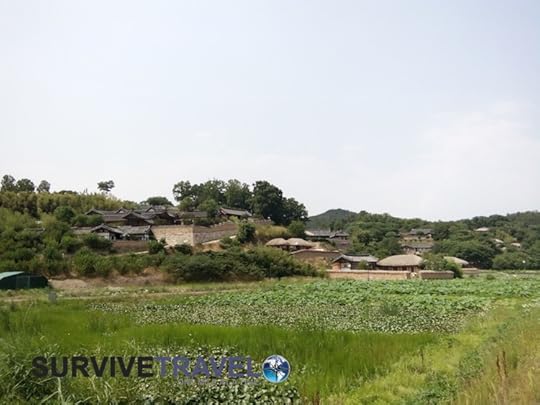
Yangdong is made up of a few smaller villages and the main thing to see is the traditional Yangdong houses, but before you go in there is this pretty nice lily pond.
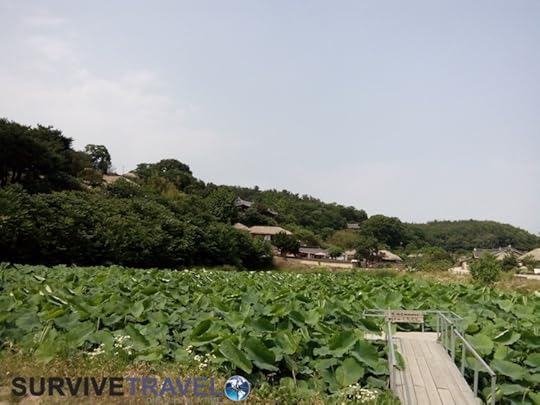
This is one of the bigger houses which is marked on the map. It is noted because of the tiled roof, which means whoever owned it was wealthier. Most of the houses are thatched roofs. I think this particular one is called Mucheomdang and belonged to one of the clan leaders.
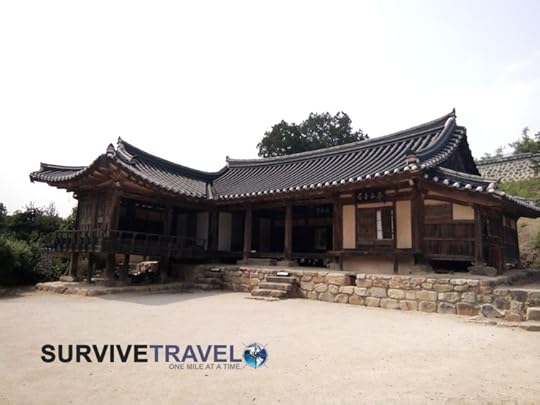
This tree is in the yard of Seobaekdong House (I think) which also belonged to the head of a clan. The tree is a few hundred years old.
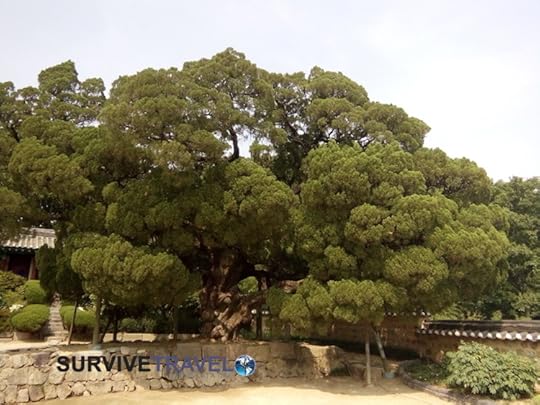
There are many more houses to look at. I think I got through about half of them when I decided I’d had enough of looking at houses. I probably would have gone back to town but the bus was not due for another two hours, then I spotted something on the far east of the map… Seongjubong Peak.
Climbing Seongjubong Peak
It took my a little bit to find the pathway. It is behind Ihyangjeoung Pavillion and is sign-posted in Korean so the map was very helpful. I went up a different one for a bit but it wasn’t a very well-kept path wich tipped me off to it being wrong, because South Korea has good maintenance.
Here’s what the proper one looks like.
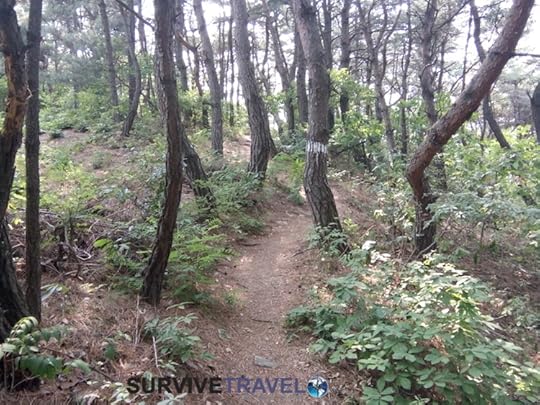
It was a really nice walk up (20-30 minutes) but the view from the top was a bit blocked by all the shrubbery. I had to climb a tree to get this photo, haven’t done that in about four years and I struggled, but it was worth it.

I explored around the peak for a bit and came across this tomb site before going back down a different path.
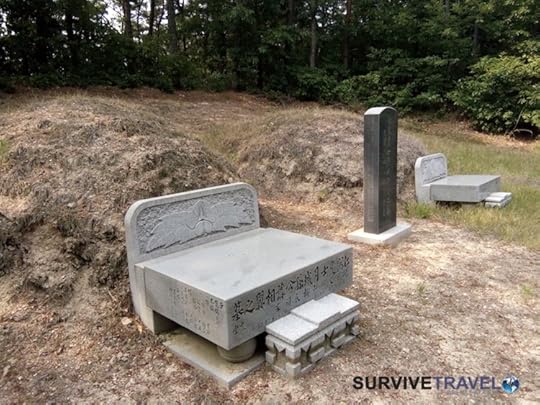
There wasn’t anyone else on the trail the whole time, but I guess it is the low season. There wasn’t many people in the village in general and many of the village shops were closed.
Getting to Yangdong Folk Village in Gyeongju
Getting to Yangdong Village was a mission, but that’s just because I’m an idiot. Most people will have no troubles because it is just one bus ride.
Catch bus 203 from the main road just north of the Intercity Bus Terminal, heading north (the same side of the road the terminal is on. It’s marked on the map below.
I read online to go to the Express Bus Terminal but I was refused when trying to board the bus. You can get off the bus there, but not on it. Luckily there was a tourist information booth just around the corner and they gave me a little timetable and directions.
The bus comes every 1-2 hours. Inside the bus terminal you can get wifi while waiting.
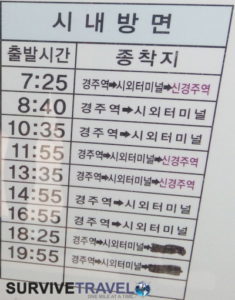
Bus times returning from Yangdong to Gyeongju.

Bus times going to Yangdong.
For some reason I got off at the wrong stop which was in the middle of two stops very far apart so I had to wait 80 minutes for the next one, but it all worked out fine in the end.
Do you agree with this Yangdong Folk Village review? Feel free to leave your own Yangdong Folk Village review (and anything else you want to say) in the comments 
June 20, 2017
Bulguksa Temple and Tohamsan Peak Review, Gyeongju, South Korea
This Bulguksa Temple and Tohamsan Peak review contains costs, directions for getting to Bulguksa Temple and Tohamsan Peak, pictures, and other useful information.
One my first full day in Gyeongju I decided to check out Bulguksa Temple and Seokguram Grotto. I never made it to the grotto but managed to get halfway up Tohamsan Peak instead.
Cost(s): 5,000 KRW for Bulguksa Temple + 5,000 KRW for Tohamsan Peak (I think).
Address: Jipum-myeon, Gyeongju-si, Gyeongsangbuk-do, South Korea.
Bulguksa Temple and Tohamsan Peak Review
Bulguksa Temple is quite a large area with a bit of an uphil climb from the main road to get there. There are quite a few different prayer halls (they have a different name for these structures, I just don’t know what it is).
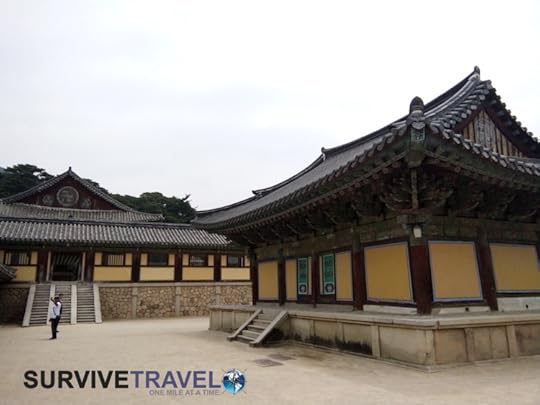
I’m not too sure what these lanterns signify but they are hanging in various parts of the temple area. Perhaps people are writing prayers on them.

Behind one of the prayer halls was this little rock garden. I wonder how long it took to stack all of these rocks?
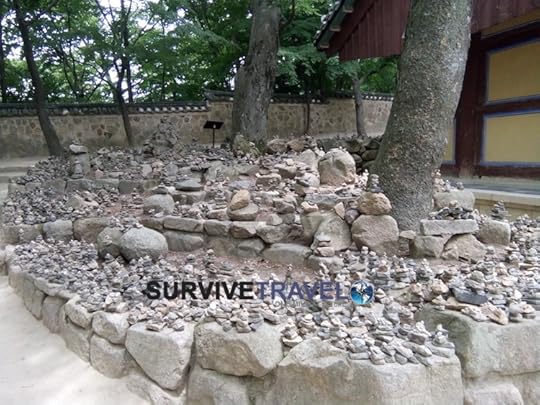
A view of one of the prayer halls from above.
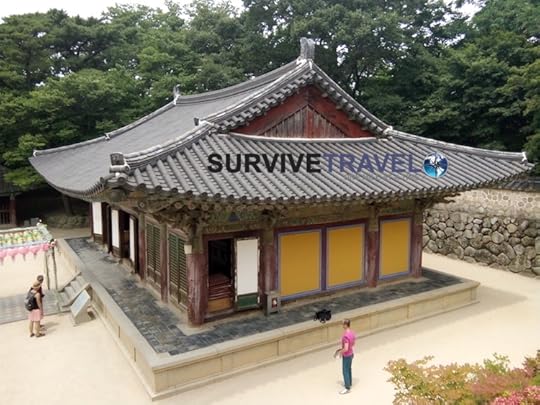
I think this might be the main courtyard.
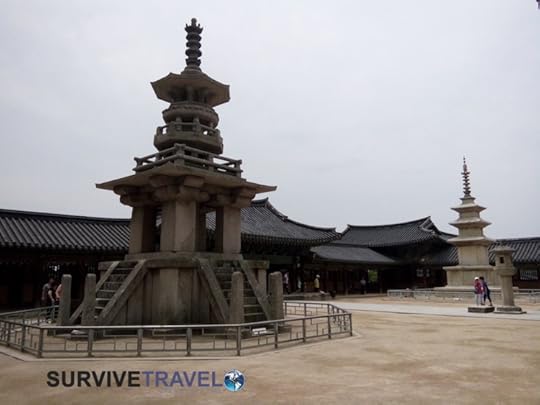
This pond is actually close to the entry but I took this photo on the way out.

Climbing Tohamsan Peak
Next to the ticket booth outside Bulguksa Temple is a hiking path to Tohamsan Peak. This first walking part is free and takes you up to the carpark of another temple and some other attractions.
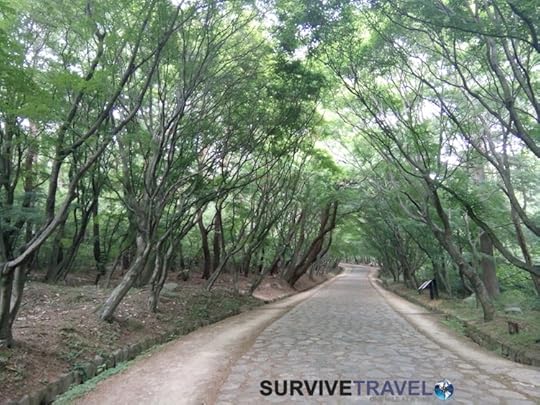
It’s a nice walk in the woods, although you are on a paved pathway big enough for a car. Luckily the road for cars is separate.
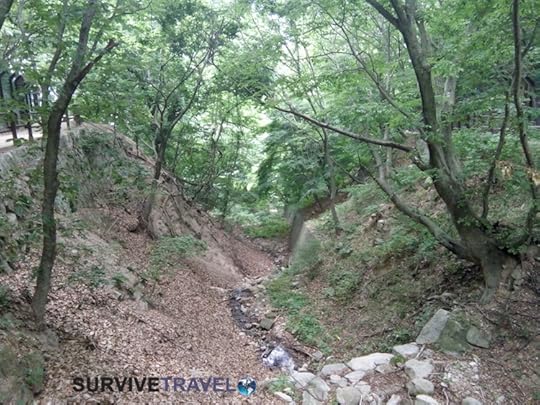
About halfway up there is a short detour (100m) to a natural spring where you can fill up your water bottle with super fresh, delicious, cold water.
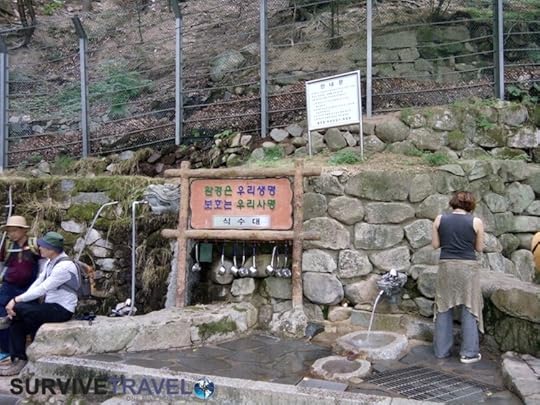
At the top of the free part you get to the carpark. I think the total distance to this point is about 2 1/2km. The peak is another 1.2km. From here you can also get to Seokguram Grotto and another shrine. It costs an extra 5,000KRW to do it, but I was getting a little hungry so decided against it.
There is also a giant bell you can “ring for mercy” for 1,000KRW. I heard it a couple of times in while walking up but did not do it myself, although I should have just to get a good picture from the viewing platform. Instead I just took one from the carpark – not so great.
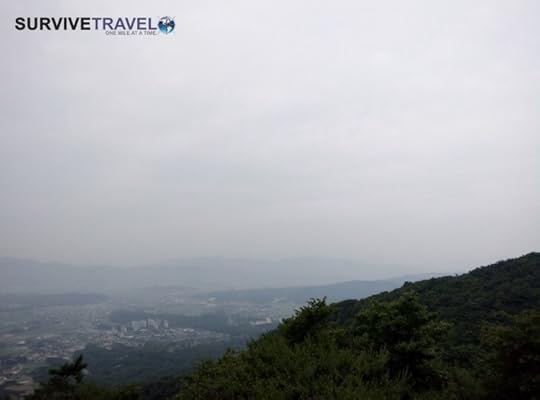
I caught the bus back down. 20 minutes down a winding road. Not sure how much it costs since I used my T-Money card. Probably about 1,500KRW. This bus also comes up from the main road (#12). I think each way every hour.
Getting to Bulguksa Temple and Tohamsan Peak
I caught the #10 bus. You can also catch the #11 or #70. All three of these can be caught from across the road from the Express Bus Terminal.
To get back catch it on the same side of the road that it drops you off at. The #10 (definitely) and I think also the #11 does a loop and will take you back to Gyeongju. You can’t catch the #70 from the opposite side of the road. It came and I tried to get on but was not allowed.
I’m not sure the cost of the bus ride. Less than 2,000KRW each way.
Bulguska temple is a little out of town, and there is another temple which is closer with a similar name so don’t get mixed up.
Do you agree with this Bulguksa Temple and Tohamsan Peak review? Feel free to leave your own XXX review (and anything else you want to say) in the comments 
June 19, 2017
Anapji Pond and its Surroundings, Gyeongju, South Korea
This post describes Anapji Pond and its surroundings including Cheomseogdae and an old palace archeological site. I arrived in Gyeongju around 5:30pm and after a little rest I went to grab some dinner. The lady at my accommodation suggested I check out Anapji Pond, so I did. I wasn’t expecting much more than a pond to walk around but it turned out to be much more, enough to write a post about it.
Cost: Free.
Address: 169-5 Cheomseong-ro, Wolseong-dong, Gyeongju, Gyeongsangbuk-do, South Korea.
Anapji Pond and its Surroundings
My plan was to walk straight from Nomad House (where I stayed) to Wolji Pond, walk around a little, and then grab some dinner. It didn’t turn out as planned.
First thing I came across were these mounds. They reminded me a lot of the Chocolate Hills in Bohol (Philippines). Turns out they are tomb mounds.
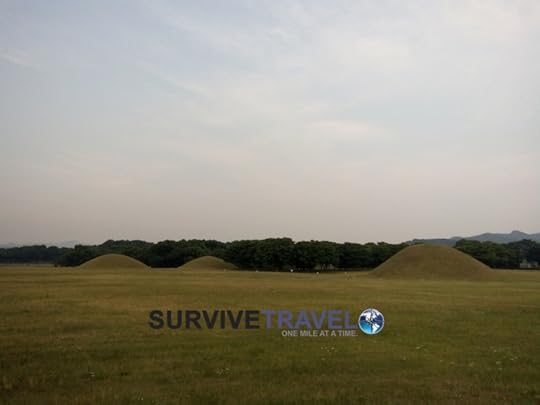
A traditional Korean house. Probably thousands of years old. The signage was in Korean so I guess I’ll never know.
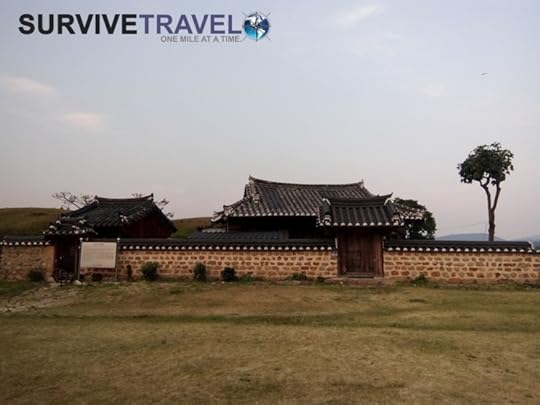
This is the oldest astro-observatory in Asia. It lights up at night (a recent addition). I think it’s called Cheomseogdae.
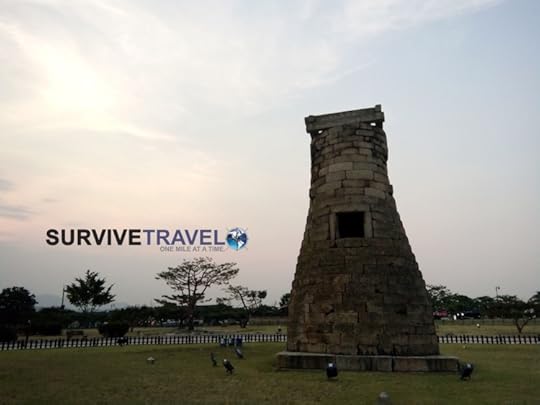
Seems to be a running theme in South Korea where they put things you can pose with for photos in fields. Actually, I see this all over Asia.
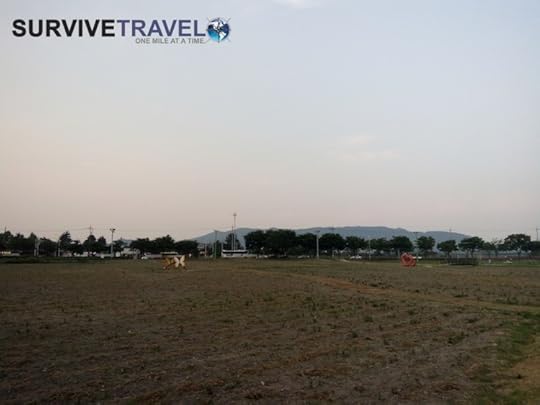
A lovely line of flowers. On the other side there were many Korean girls getting their pictures taken with these flowers in the background.
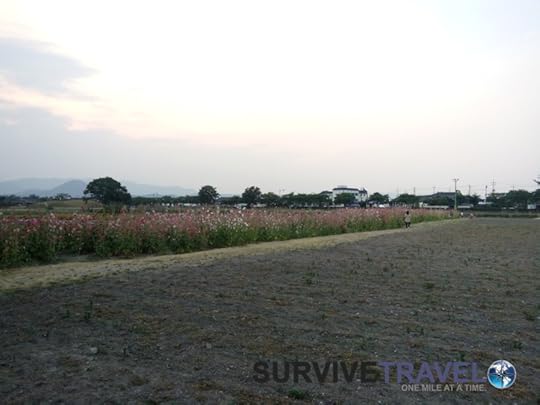
A pond full of lilies, but not Anapji Pond.
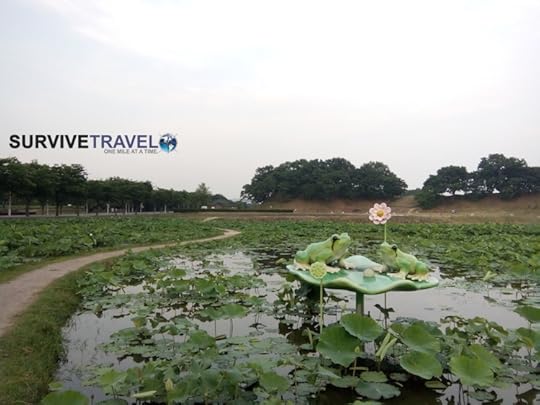
So far all these things have been on one side of the road. Across the road from the pond pictured above is the actual Anapji Pond, which is the next picture.

An archeological Site
Back on the side of the road I was on originally you can follow a path up the hill to see an archeological site where a palace used to be.
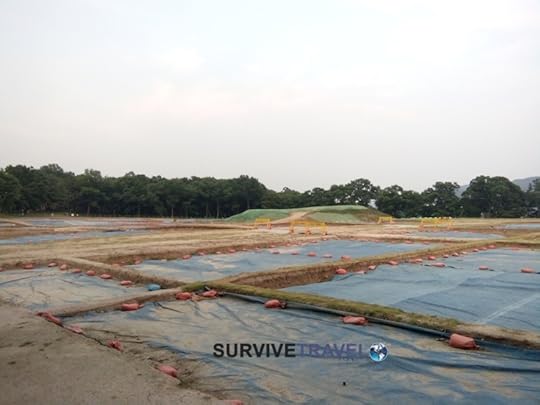
After the palace is a small forest. I think it is thought that some leader of a great clan was born inside this forest. It is nice to walk through.
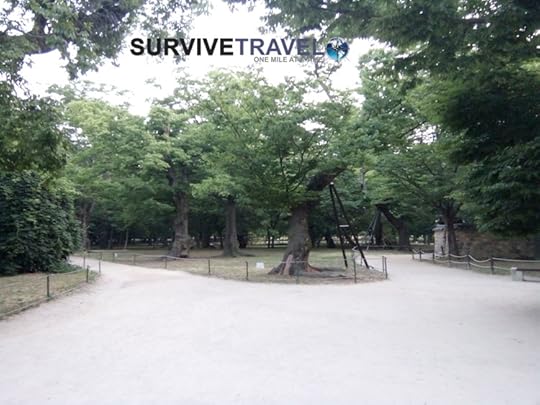
At the end you can explore this Hyanggyo, which is an old government run school (thousands of years old). It was burned down by the Japanese but has now been restored. It is not operational, and I don’t think it has been for at least hundreds of years.
This is just one of the buildings inside the complex.
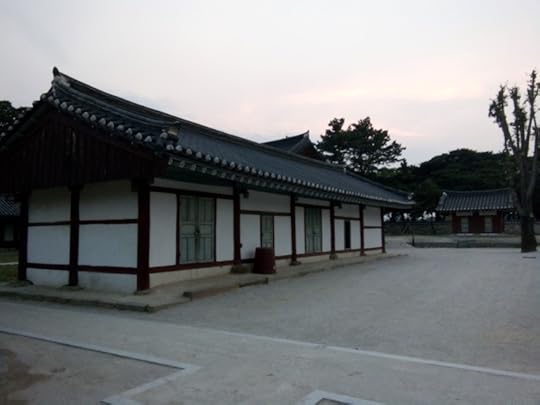
After all that I came down the hill and was where I had started, near the observatory.
Getting to Anapji Pond and its Surroundings
Gyeongjiu is small. Walk there from where-ever you accommodation is. If you feel lazy you can catch a cab. Shouldn’t cost more than 5,000 KRW. Im sure buses go there too. Maybe the 10 or 11, but I’m not certain.
Have you explored Anapji Pond and its surroundings before? Leave your thoughts in the comments 
Donggung Palace and Wolji Pond Review, Gyeongju, South Korea
This Donggung Palace and Wolji Pond review contains costs, directions for getting to Donggung Palace and Wolji Pond, pictures, and other useful information.
I arrived in Gyeongju around 5:30pm and after a little rest I went to grab some dinner. The lady at my accommodation suggested I check out Wolji Pond (a.k.a. Anapji Pond), so I did. I wasn’t expecting much more than a pond to walk around but it turned out to be much more, enough to write a post about it.
Cost: Free.
Address: 102 Wonhwa-ro, Wolseong-dong, Gyeongju, Gyeongsangbuk-do, South Korea. guide.gyeongju.go.kr. +82 54-772-4041.
Donggung Palace and Wolji Pond
My plan was to walk straight from Nomad House (where I stayed) to Wolji Pond, walk around a little, and then grab some dinner. It didn’t turn out as planned.
First thing I came across were these mounds. They reminded me a lot of the Chocolate Hills in Bohol (Philippines). I saw one with a gravestone in front of it some I am not sure if they are all tombs or not, but I’m inclined to think they are natural.

A traditional Korean house. Probably thousands of years old. The signage was in Korean so I guess I’ll never know.

This is the oldest astro-observatory in Asia. It lights up at night (a recent addition).

Seems to be a running theme in South Korea where they put things you can pose with for photos in fields. Actually, I see this all over Asia.

A lovely line of flowers. On the other side there were many Korean girls getting their pictures taken with these flowers in the background.

A pond full of lilies, but not Anapji Pond.

So far all these things have been on one side of the road. Across the road from the pond pictured above is the actual Anapji Pond, which is the next picture.

Back on the side of the road I was on originally you can follow a path up the hill to see an archeological site where a palace used to be – Donggung Palace I assume.

After the palace is a small forest. I think it is thought that some leader of a great clan was born inside this forest. It is nice to walk through.

At the end you can explore this Hyanggyo, which is an old government run school (thousands of years old). It was burned down by the Japanese but has now been restored. It is not operational, and I don’t think it has been for at least hundreds of years.
This is just one of the buildings inside the complex.

After all that I came down the hill and was where I had started, near the observatory.
Getting to Donggung Palace and Wolji Pond in Gyeongjiu
Gyeongjiu is small. Walk there from where-ever you accommodation is. If you feel lazy you can catch a cab. Shouldn’t cost more than 5,000 KRW.Im sure buses go there too. Maybe the 10 or 11, but I’m not certain.
Do you agree with this Donggung Palace and Wolji Pond review? Feel free to leave your own Donggung Palace and Wolji Pond review (and anything else you want to say) in the comments 
June 18, 2017
Haneul Park Review, Seoul, South Korea
This Haneul Park review contains costs, directions for getting to Haneul Park, pictures, and other useful information.
Following a bit of a chill day I decided to go to Hanuel Park, which unexpectedly (but pleasantly) turned out to be a bit of a hiking adventure.
Hanuel Park is one of the 3 or 4 parks in the Olympic Park area. I didn’t look at any of the other parks because it was a lovely sunny day and I forgot my hat and had no sunscreen, but just walking around Hanuel Park was a nice little hike so it was a good day.
Address: 487-48 Sangam-dong, Mapo-gu, Seoul, South Korea. worldcuppark.seoul.go.kr. +82 2-300-5501.
Haneul Park Review
This lake is actually in a different park, but you go past it one the way to Hanuel Park. There are lots of family’s having picnics (it was a Sunday) and also many bicycle riders. The park caters well for both these activities.

Heading towards the hill that is Hanuel Park I came across this photo shoot. My guess is that they hired a model for an amateurs photography club.

Over the bridge and then up the stairs into Haneul Park. It took much less time to climb than I expected. Only about ten minutes.

The view from the top of the stairs, all 292 of them. No, I didn’t count them. Every tenth step was numbered.

You get to choose between going right to Haneul Park or left to the Forest Path of Hope (I think that’s what it was called). Although the Forest Path of Hope sounded intriguing I decided to stick to the plan and went right to Hanuel Park. I figured I could do the Forest Path of Hope afterwards.

Finally I got to the top of Hanuel Park and there are more picnics going on. Korean picnics look amazing.
The actual park itself are small fields of different species of grass and places to pose for pictures.

Walking towards the main viewing point overlooking the river.

One of the side paths lined with shelters.

A living sculpture, i.e., a metal frame with plant-life on it. You can go in and up it for a good view.

Near the living sculpture is the path with little windmills. There are also a few actual windmills in the park.

A nice view of Haneul Park from the top of the the living sculpture.

The main scenic view overlooking the river.

After that I decided to do the walk the Forest Path of Hope. I was glad I left it till after Haneul Park because it takes you back down the hill.

It’s a nice walk down. I’m always happy to take a different route.

There are a couple of scenery changes. It was actually really nice, regardless of being able to hear the highway.

After my hike in Haneul Park I went into the Olympic Park Mall. It’s a pretty big mall with a big supermarket, a food court, and other shops you’d expect to find in a mall.
Getting to Haneul Park in Seoul
Catch the metro to Olympic Park Station. Take the Olympic Park Exit and walk straight when coming out of the station. Follow the (huge) main road, past the hire bikes, until you get to the pedestrian crossing, then cross the street.
Walk across the massive carpark until you get to the big lake. Now you are in Pyounghwa Park (I think that’s the name, theres about 4 parks in that area).
To the NW you can see the hill with the stairs going up. Go there, that is Haneul Park. There are signs to help you.
Do you agree with this Haneul Park review? Feel free to leave your own Haneul Park review (and anything else you want to say) in the comments 
June 16, 2017
Cheonggyecheon Stream Review, Seoul
This Cheonggyecheon Stream review contains costs, directions for getting to Cheonggyecheon Stream, pictures, and other useful information.
I originally went to Cheonggye Plaza from Ihwa Mural Village not really knowing what it was. Actually, Cheonggye Plaza itself was kind of like a farmers market and with some local snack foods and vegetables. Not really something I am interested in, but it was also the start (or end) of Cheonggyecheon Stream, which is just the kind of thing I am interested in.
Address: 148 Seorin-dong, Jongno-gu, Seoul, South Korea
Cheonggyecheon Stream Review
I decided to just walk along the stream all the way back to my accommodation. It was a pretty nice walk and lots of places to stop and sit under bridges.
There’s also lots of things to see along the way.
This is the start/end, at Cheonggye Plaza.
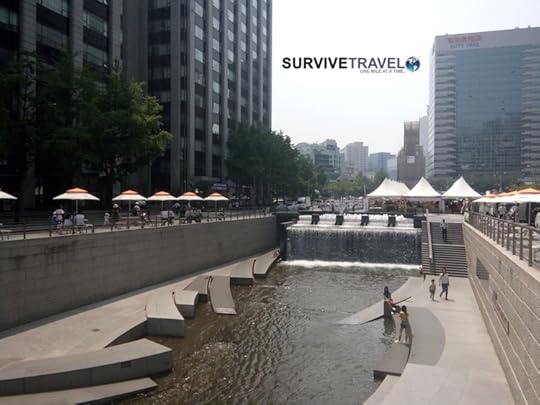
Looking down stream from Cheonggye Plaza.
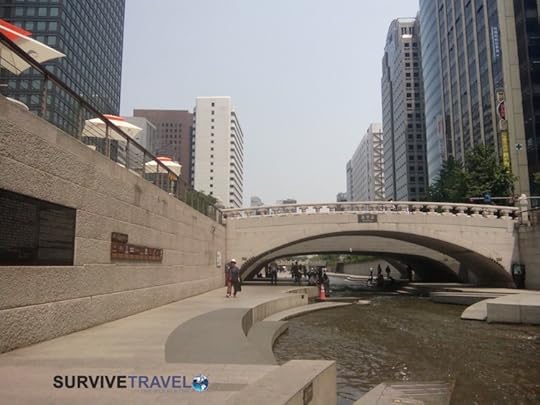
A kind of arty display of flowers on the wall. There was more on the other side of the stream also.
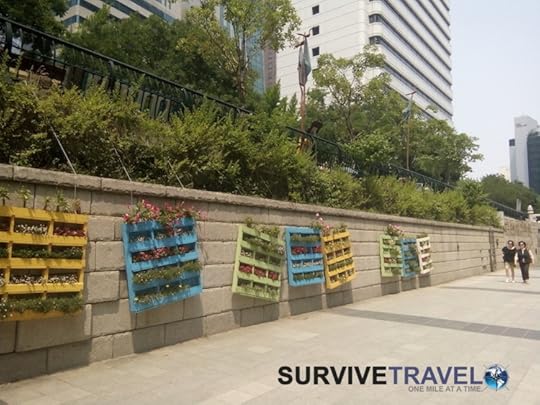
Carvings in the stone under one of the small bridges.
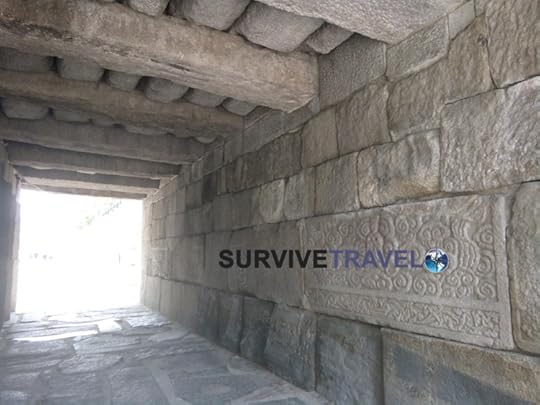
This photo display goes along three walls. All the signs were in Korean so I couldn’t know for certain, but this first display seems to be from the war.
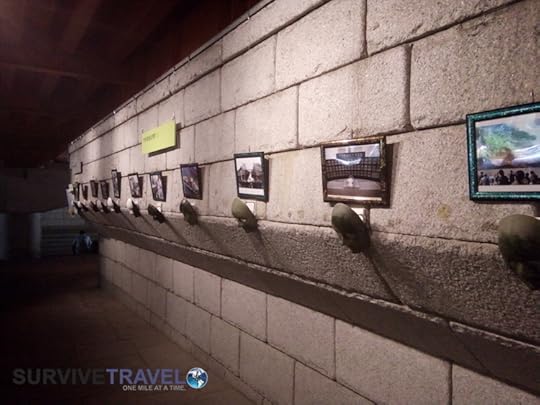
Artwork on the wall.
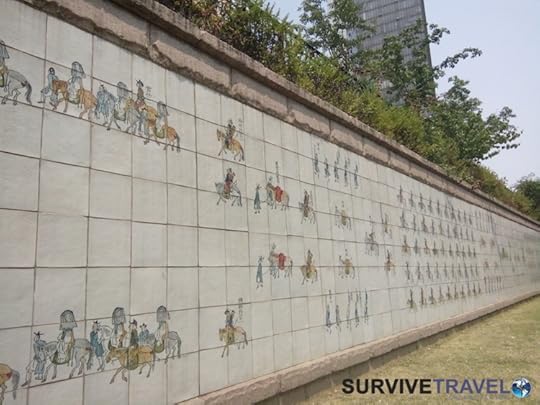
This is the only thing I actually got the name of. It was called the wall of water.
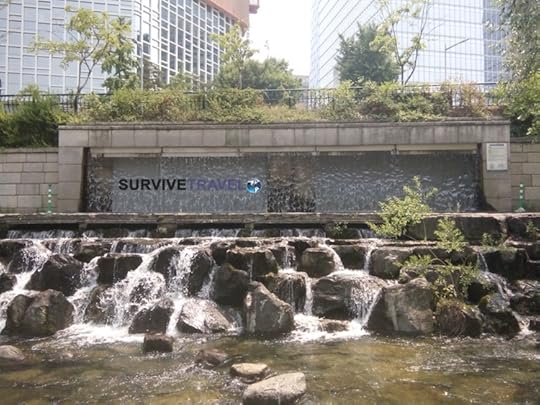
More artwork. This time underneath one of the larger bridges.
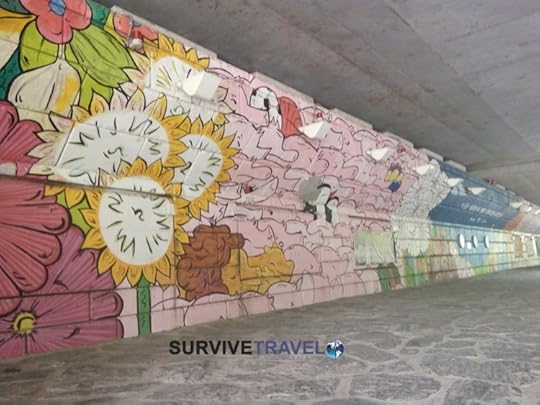
The last bit of artwork I saw before going back to the streets. All along the river there are people just chilling, mostly under the shade of the bridges.
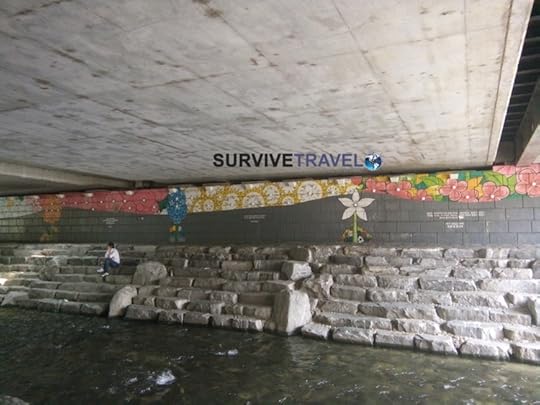
Getting to Cheonggyecheon Stream
Cheonggyecheon Stream is pretty long. You can walk to any point of it.
The closest metro station to Cheonggye Plaza is City Hall.
Do you agree with this Cheonggyecheon Stream review? Feel free to leave your own Cheonggyecheon Stream review (and anything else you want to say) in the comments 
Ihwa Mural Village Review, Seoul, Korea
This Ihwa Mural Village review contains costs, directions for getting to Ihwa Mural Village, pictures, and other useful information.
After a late arrival and nice sleep-in I decided to go for a walk to the Ihwa Mural Village only a couple of km north of where I was staying (Dongdaemun Inn). This type of activity really is one of my favorite things to do in any city that has something similiar. It is basically just walking around looking at street art.
Address: 6-18 Ihwa-dong, Jongno-gu, Seoul, South Korea.
Ihwa Mural Village Review
There isn’t really much I can say about Ihwa Mural Village. You just walk around and look at the art.
These first three are at the entry of the village. Your not really inside Ihwa yet, but you know you’re there.



A little bit off the main path but lots to be found in the alleys.


One of my favorite pieces. I had to wait a while to get a clear shot of it, i.e., without other tourists posing.

There’s a few stairs in Ihwa Mural Village, and a worthwhile view from the top.

Love pandas.

This shop had a sign saying “Free Cat Art”. I guess if you buy something they give you one off the fence.

Near the end of the circuit.

Either they painted around a plaster mishap, or it was all done on purpose.

According to the map this is actually the first mural in the circuit. I guess I missed it on the way in.

Getting to Ihwa Mural Village
I just walked there. You could take a bus or metro so somewhere kind of close. I think you will have to walk at least 500m regardless, and of cource once you are there it is all walking.
The closest metro station would probably be Jongno 5-ga.
Do you agree with this Ihwa Mural Village review? Feel free to leave your own Ihwa Mural Village review (and anything else you want to say) in the comments 
June 11, 2017
14 Awesome Things to do in Dumaguete, Philippines
This list of 14 awesome things to do in Dumaguete gives a short review of each of the things to do in Dumaguete, links to more detailed reviews (where applicable), and advise on accommodation in Dumaguete as well as information on getting to Dumaguete.
I had decided to kill some time in the Philippines before heading to Colombia, 5 months worth of time. After my experience living in Baybay I decided to find somewhere a little bigger. I had heard many good things about Dumaguete so that is were I landed.
14 Awesome Things to do in Dumaguete
Since I lived in Dumaguete, as opposed to just sightseeing, a lot of the items on this awesome things to do in Dumaguete are just “every day” things.
1. Swimming
One of the things I did the most often in Dumaguete was go swimming at the local public pool. I was awesome because it was super cheap (40php per session), within walking distance to my apartment, and often I was the only one there.

A swimming carnival at the public pool. Usually there are much less people.
2. Jogging
For six weeks in April/May they closed the pool to the public so they could give “Learn to Swim” lessons so I decided to use the running track instead.
Actually, I never got around to using the running track. During the six weeks that the pool was closed I got tonsillitis pretty bad and couldn’t do anything for 3 to 4 weeks. After that I lost motivation to buy running shoes so I just waited until the pool re-opened.

Running track in Dumaguete.
3. Library
I kept hearing about the local foreigners buying books or doing book swaps, but next to the fire station is a small public library. It had a decent collection of English novels on the second floor which kept me busy.
4. Casaroo Falls
After more than 4 months living in Dumaguete we decided it was time to hire a motorbike and go see the surrounding area. Casaroo falls was the first place we went. It consisted of small cascading falls, many stairs to climb, and the quiet of nature.
I think there is a big waterfall there but we just didn’t walk up the river enough.

5. Red Rock Falls (Pulangbato Falls)
After Casaroo Falls we went to Red Rock Falls which had numerous swimming areas, a bbq area, cafeteria, and many more people.
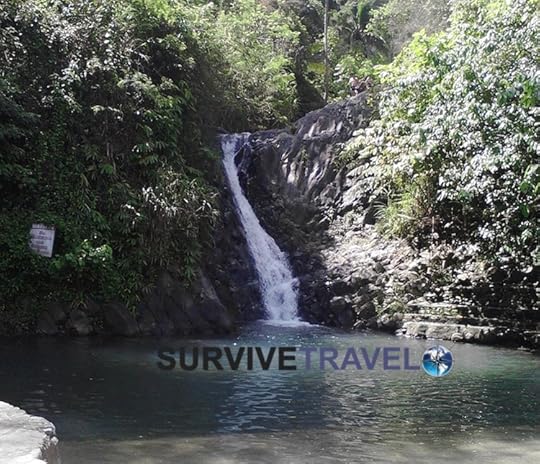
The pool I went for a quick dip in. Looks quiet but about 30 seconds after taking this ten or so people jumped in.
6. Red Rock Hot Springs
On the road into Red Rock Falls there is the Red Rock Hot Springs which was a pool filled with the warm natural mineral water from the mountains. Five minutes after we arrived everyone left and we had the whole place to ourselves. It was really nice.

The pool with fountains.
7. Twin Lakes
Our last stop on our “big day out” was Twin Lakes. It took ages to get there but was pretty nice. There is a short jungle hike from one lake to the other.

The first lake. I forgot the name of it.
8. Eat on the Riverside
We managed to arrive back in Dumaguete just before 7:30pm to return the bike and then went for overpriced but pretty nice pizza and beer on the riverside. One of the big draws to the riverside at night-time is the BBQ.

Riverfront in Dumaguete.
9. Massage
The following day after our day out we were sore from all the hiking, so we waited a few days and then got massages in town. There’s lots of choice. In the Philippines I always recommend Nuat Thai because I love Thai massages and they specialize in them.
10. Cathedral
There’s the main cathedral in town which I guess is something to look around for a bit.

The main Cathedral in Dumaguete.
11. Watchtower
Next to the cathedral is the watchtower.

I think it’s a watchtower. Maybe a bell tower.
12. Public Market
I wouldn’t call a Filipino public market a tourist attraction because there is one in every city. I guess if you’ve never seen one before then it is worth a look. Personally, I love the fresh markets way better than the supermarket. We went there about once a week to stock up on vegetables, rice, and tofu.

Once a week we would buy vegetables an old lady’s stall outside the market. Super fresh and super cheap. This is not the stall, or my photo.
Photo Credit: Yvette Tan vi Flikr. Cropped.
13. Siliman University (Zoo & Museum)
There’s a zoo and museum in the Siliman university but we never bothered to see them. Anna wouldn’t be interested in the museum and I refuse to support the keeping of animals in jail – so no pic.
14. Robinsons Mall
Robinson’s mall is different from the supermarket in the city so make sure you clarify if taking a tricycle. This is a proper mall complete with cinemas and overpriced shops. We only went there to get coconut water when we couldn’t find any in town. Get there by tricycle from town for about 10php.
Getting to Dumaguete
From Cebu City catch a taxi to the South bus terminal.
Get on a bus to Lilian port. It takes about 5 hours and costs 200php per person.
The ferry from Liloan to Dumaguete is 62php per person and takes less than 30 minutes.
Finally, a tricycle to town costs about 150php (depending on your bargaining skills) or you could catch a jeepney to town which would only cost about 12php.
Alternatively you can just catch a bus that will take you to the port, go on the ferry, then take you to the bus station on the other side. That’s how we will get back to Cebu in a couple of days. Seems like a lot less hassle and pretty much the same price.
Got anything to add to this list of awesome things to do in Dumaguete? Let us know them (or anything else you want to say) in the comments 



